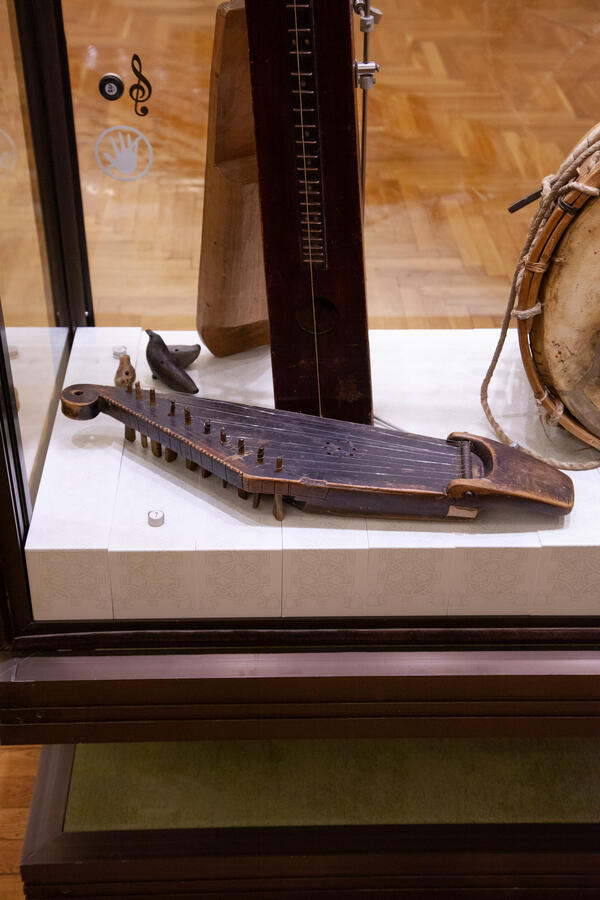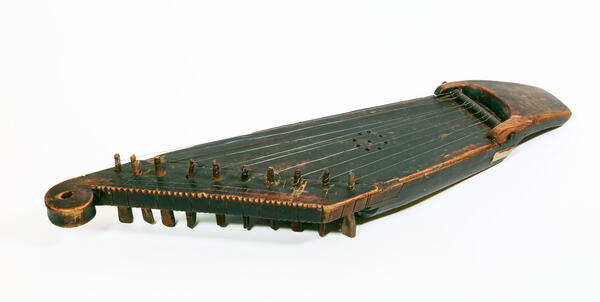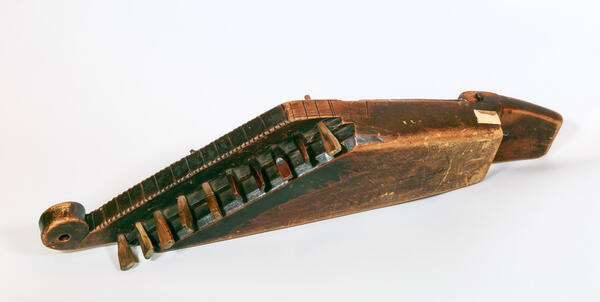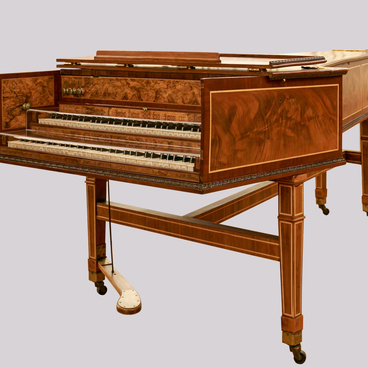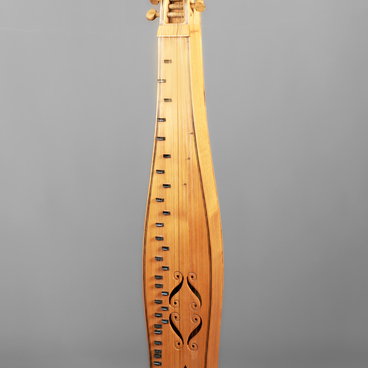The Museum of Music houses twelve kanteles — plucked instruments with ten strings. These include nine Karelian and three Finnish kanteles. The permanent exposition demonstrates the earliest kantele from the museum’s collection — the Karelian kantele manufactured by an unknown craftsman in 1886.
This instrument is similar to the Russian gusli. Its body has a trapezoidal shape and is made of birch wood, with the soundboard made of spruce. Ten metal strings run over the instrument’s body in a slightly fan-shaped arrangement. The narrow tip of the body has brackets with a string holder fixed between them. The wide diagonal tip of the instrument has wooden pegs inserted into round holes.
The word “kantele” comes from the proto-Baltic languages and most likely originates from the words “kansi, ” “kanta, ” or “kanto, ” which mean “a lid, ” “to wear, ” and “a tree stub, ” respectively. The poetic origin of the kantele is described in the famous Karelian and Finnish epic “Kalevala.”
Its legendary main character mage Väinämöinen made a kantele using the jawbone of a pike for the instrument’s body and horsehair for the strings. He was the only one who was able to play the kantele, and no one could hold back tears while listening to his charming music. “All the creatures on land, at sea, and in the air, including birds, fish, and animals, came to listen to him play… and wept with joy.”
Traditional kanteles of artists from Karelian villages had between five and twenty-four strings. The earliest kanteles had gut strings, while later instruments had metal strings. Earlier instruments were hollowed from the bottom and had an open body, while the more advanced versions, such as the one from the museum’s collection, were hollowed from the top and covered by a soundboard with resonator holes.
Later, craftsmen started making kanteles by gluing together a body from pieces of alder, spruce, pine, or birch. For a long time, the instrument had a diatonic tuning and could produce only a limited number of melodies.
In the 1920s and 1930s, Viktor Gudkov, a poet, composer, anthropologist, and folklore specialist, decided to revive traditional folk instruments. He created a family of chromatic kanteles.
Gudkov’s creative work helped to create a unique Karelian ensemble. In 1936, it was transformed into the State National Song and Dance Company “Kantele.”
This instrument is similar to the Russian gusli. Its body has a trapezoidal shape and is made of birch wood, with the soundboard made of spruce. Ten metal strings run over the instrument’s body in a slightly fan-shaped arrangement. The narrow tip of the body has brackets with a string holder fixed between them. The wide diagonal tip of the instrument has wooden pegs inserted into round holes.
The word “kantele” comes from the proto-Baltic languages and most likely originates from the words “kansi, ” “kanta, ” or “kanto, ” which mean “a lid, ” “to wear, ” and “a tree stub, ” respectively. The poetic origin of the kantele is described in the famous Karelian and Finnish epic “Kalevala.”
Its legendary main character mage Väinämöinen made a kantele using the jawbone of a pike for the instrument’s body and horsehair for the strings. He was the only one who was able to play the kantele, and no one could hold back tears while listening to his charming music. “All the creatures on land, at sea, and in the air, including birds, fish, and animals, came to listen to him play… and wept with joy.”
Traditional kanteles of artists from Karelian villages had between five and twenty-four strings. The earliest kanteles had gut strings, while later instruments had metal strings. Earlier instruments were hollowed from the bottom and had an open body, while the more advanced versions, such as the one from the museum’s collection, were hollowed from the top and covered by a soundboard with resonator holes.
Later, craftsmen started making kanteles by gluing together a body from pieces of alder, spruce, pine, or birch. For a long time, the instrument had a diatonic tuning and could produce only a limited number of melodies.
In the 1920s and 1930s, Viktor Gudkov, a poet, composer, anthropologist, and folklore specialist, decided to revive traditional folk instruments. He created a family of chromatic kanteles.
Gudkov’s creative work helped to create a unique Karelian ensemble. In 1936, it was transformed into the State National Song and Dance Company “Kantele.”

